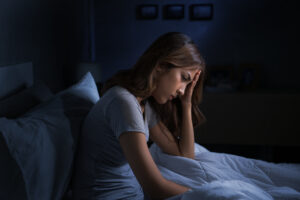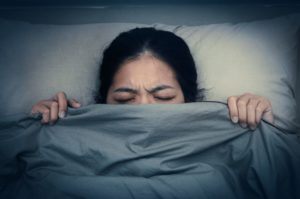Sleep Talking: What Is Somniloquy?
- Sleep talking, or somniloquy, is a sleep disorder most common during adolescence.
- Exact cause is unclear, but sleep talking may be triggered by stress and mental health conditions.
- Avoiding stimulants and electronics before bed may help reduce its occurrence during sleep.
- Partners of sleep talkers can try ear plugs and white noise machines to drown out nighttime disruptions.
Sleep talking, formally known as somniloquy, is a sleep disorder defined as talking during sleep without being aware of it. Sleep talking can involve complicated dialogues or monologues, complete gibberish or mumbling. The good news is that for most people it is a rare and short-lived occurrence.
It’s common for people to experience at least one episode of sleep talking during their life, making it one of the most common abnormal behaviors that can occur during sleep. Research has helped clarify the symptoms and consequences of sleep talking, but there is much that remains unknown about the causes and treatment of this condition.
Is Your Troubled Sleep a Health Risk?
A variety of issues can cause problems sleeping. Answer three questions to understand if it’s a concern you should worry about.
What Is Sleep Talking?
Sleep talking is a type of parasomnia. Parasomnias are abnormal behaviors during sleep. Unlike most parasomnias that happen only during specific parts of the sleep cycle, sleep talking can occur during either rapid eye movement (REM) or non-REM sleep.
Sleep talking is considered to be distinct from other vocalizations that can occur during sleep such as catathrenia , a breathing disorder that causes audible groaning, or REM sleep behavior disorder (RBD), which involves a person physically acting out their dreams.
How Common Is Sleep Talking?
Studies have found that up to 66% of people have experienced episodes of sleep talking, making it one of the most common parasomnias. That said, it does not occur frequently, with just 17% of people reporting sleep talking episodes in the last three months. Even regular sleep talkers may have to be recorded for four nights or more to document an episode.
Sleep talking is found more often in children and is believed to affect fewer adults. It occurs equally in women and men. However, because an individual is very rarely aware of episodes, data about the prevalence of sleep talking may not be exact. Reports of sleep talking usually come from a family member or bed partner.
What Are the Symptoms of Sleep Talking?
The central symptom of sleep talking is audible expression that occurs during sleep without the person being aware of it happening. It can be gibberish or resemble normal speech.
A linguistic study of somniloquy found that around half of recorded sleep talking was incomprehensible . In these cases, sleep talking was normally mumbling, silent speech (moving the lips with limited noise), or was muffled by pillows or blankets.
The other half of sleep talking that was comprehensible had a number of parallels to typical conversations. For example, it usually followed typical standards of grammar and included pauses as if talking with another person.

Many of the recorded utterances were negative, exclamatory, or profane, indicating that sleep talking may reflect conflict-driven dialogue taking place in the brain during sleep. However, people are very rarely aware that they are talking in their sleep at the time and typically have no recollection of the episodes when they wake up. Episodes of sleep talking tend to be short, and they rarely involve drawn-out conversations. The total episode may involve only a handful of words or a few sentences.
Research is mixed about the source of the content during episodes of sleep talking. Speech may not have any clear connection to a person’s life, recent events, or prior conversations. Some evidence indicates that it may at times be related to dreams , but not all sleep talking appears to be closely tied to dream activity.
Is Sleep Talking Dangerous?
In the majority of cases, sleep talking is harmless. It doesn’t usually have a major effect on the person’s sleep, and it normally doesn’t occur frequently enough to cause any serious problems. However, there are some situations in which sleep talking can cause problems:
- If sleep talking bothers a bed partner or roommate, it may interrupt their sleep and contribute to problems like insomnia or excessive daytime sleepiness.
- If the content of sleep talking is embarrassing, it may create awkwardness or stress between the person talking in their sleep and their bed partner.
- If sleep talking occurs alongside other parasomnias, such as nightmare disorder or sleepwalking, it may be connected to bigger sleeping difficulties that can cause fragmented or insufficient sleep.
What Causes Sleep Talking?
Experts aren’t sure exactly why people talk in their sleep. There is evidence that it may have a genetic component with some studies finding that sleep talking can run in families.
In studies of twins, sleep talking was found to co-occur more frequently with sleepwalking, teeth grinding, and nightmares in both children and adults, and these all may share some genetic relationship. Further research is needed to better understand these potential connections.
Sleep talking appears to occur more often in people with mental health conditions . In particular, it is believed to occur most frequently in people with post-traumatic stress disorder (PTSD). Overall, though, most cases of sleep talking are not thought to be connected to mental illness.
How Can You Stop Sleep Talking?
Because the cause of sleep talking is not fully understood, there is limited knowledge about proven methods to stop sleep talking. In most situations, treatment for sleep talking is unnecessary because of its limited frequency and minimal negative consequences.
For people who want to try to limit or eliminate sleep talking episodes, focusing on sleep hygiene may be a helpful starting point. Most parasomnias are thought to be an abnormal state that blends wakefulness and sleep, and this state may be more likely to arise when normal sleep patterns are disturbed. For that reason, steps that promote consistent and stable sleep may help ward off parasomnias, including sleep talking.
Sleep hygiene includes a person’s sleep environment and their habits that can affect sleep. While healthy sleep tips can be adapted to fit an individual’s situation and eliminate potential causes of sleep interruptions, some of the key ways to enhance sleep hygiene include:
- Keeping a consistent sleep schedule every day, including on weekends.
- Avoiding caffeine or other stimulants late in the afternoon and evening.
- Giving yourself time to wind down and relax, including by dimming lights and putting away electronic devices for at least a half-hour before bedtime.
- Getting regular exposure to daylight and finding time for physical activity during the day.
- Creating a distraction-free sleep space that has limited light or sound pollution.
- Setting up a cozy sleep surface with the best mattresses, best pillows, and best bedding for your needs
People who are bothered by ongoing sleep talking, suffer from other sleeping problems, and/or have excessive drowsiness during the day should talk with their doctor who can help get to the bottom of those issues and recommend the most appropriate treatment.
How Can Bed Partners of Sleep Talkers Get Better Sleep?
It’s often bed partners or roommates of people who talk in their sleep who bear the brunt of the negative consequences of somniloquy. They may find themselves awoken unexpectedly in the night by sleep talking or be bothered or offended by its content.
If sleep talking is creating these problems on a regular basis, a focus on sleep hygiene may help their bed partner decrease the frequency of sleep talking episodes. In addition, other steps may help cut down on the disturbance from a bed partner’s sleep talking:
- Wearing ear plugs or headphones to block out the sleep talking.
- Using a white noise machine or a fan to create a soothing and stable background noise that drowns out most sleep talking.
- If necessary, sleeping in different rooms can keep the noise of sleep talking from causing nighttime interruptions.
If there are any other sleep disturbances or excessive daytime sleepiness along with sleep talking, sleep apnea should be considered. Consultation with a sleep doctor can help you to evaluate this.

Still have questions? Ask our community!
Join our Sleep Care Community — a trusted hub of sleep health professionals, product specialists, and people just like you. Whether you need expert sleep advice for your insomnia or you’re searching for the perfect mattress, we’ve got you covered. Get personalized guidance from the experts who know sleep best.
References
6 Sources
-
Alonso J, Camacho M, Chhetri DK, Guilleminault C, Zaghi S. Catathrenia (Nocturnal Groaning): A Social Media Survey and State-of-the-Art Review. J Clin Sleep Med. 2017;13(4):613-622. Published 2017 Apr 15.
https://pubmed.ncbi.nlm.nih.gov/28095968/ -
Bjorvatn, B., Grønli, J., & Pallesen, S. (2010). Prevalence of different parasomnias in the general population. Sleep medicine, 11(10), 1031–1034.
https://pubmed.ncbi.nlm.nih.gov/21093361/ -
Arnulf I, Uguccioni G, Gay F, et al. What Does the Sleeping Brain Say? Syntax and Semantics of Sleep Talking in Healthy Subjects and in Parasomnia Patients. Sleep. 2017;40(11):10.1093/sleep/zsx159.
http://academic.oup.com/sleep/article/doi/10.1093/sleep/zsx159/4345704 -
Nielsen T, Svob C, Kuiken D. Dream-enacting behaviors in a normal population. Sleep. 2009;32(12):1629-1636.
https://pubmed.ncbi.nlm.nih.gov/20041599/ -
Hublin C, Kaprio J, Partinen M, Koskenvu M. Parasomnias: co-occurrence and genetics. Psychiatr Genet. 2001;11(2):65-70.
http://journals.lww.com/00041444-200106000-00002 -
Hublin C, Kaprio J, Partinen M, Koskenvuo M. Sleeptalking in twins: epidemiology and psychiatric comorbidity. Behav Genet. 1998;28(4):289-298.
http://link.springer.com/10.1023/A:1021623430813














